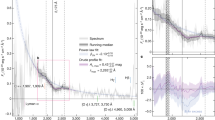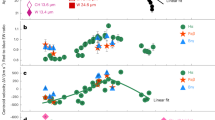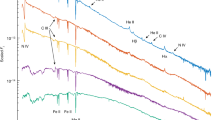Abstract
The origin of dust in galaxies is still a mystery1,2,3,4. The majority of the refractory elements are produced in supernova explosions, but it is unclear how and where dust grains condense and grow, and how they avoid destruction in the harsh environments of star-forming galaxies. The recent detection of 0.1 to 0.5 solar masses of dust in nearby supernova remnants5,6,7 suggests in situ dust formation, while other observations reveal very little dust in supernovae in the first few years after explosion1,8,9,10. Observations of the spectral evolution of the bright SN 2010jl have been interpreted as pre-existing dust11, dust formation12,13 or no dust at all14. Here we report the rapid (40 to 240 days) formation of dust in its dense circumstellar medium. The wavelength-dependent extinction of this dust reveals the presence of very large (exceeding one micrometre) grains, which resist destruction15. At later times (500 to 900 days), the near-infrared thermal emission shows an accelerated growth in dust mass, marking the transition of the dust source from the circumstellar medium to the ejecta. This provides the link between the early and late dust mass evolution in supernovae with dense circumstellar media.
This is a preview of subscription content, access via your institution
Access options
Subscribe to this journal
Receive 51 print issues and online access
$199.00 per year
only $3.90 per issue
Buy this article
- Purchase on Springer Link
- Instant access to full article PDF
Prices may be subject to local taxes which are calculated during checkout




Similar content being viewed by others
References
Gall, C., Hjorth, J. & Andersen, A. C. Production of dust by massive stars at high redshift. Astron. Astrophys. Rev. 19, 43 (2011)
Matsuura, M. et al. The global gas and dust budget of the Large Magellanic Cloud: AGB stars and supernovae, and the impact on the ISM evolution. Mon. Not. R. Astron. Soc. 396, 918–934 (2009)
Draine, B. T. in Cosmic Dust—Near and Far (eds Henning, T., Grün, E. & Steinacker, J. ) Vol. 414, 453–472 (Astronomical Society of the Pacific Conference Series, 2009)
Dunne, L. et al. Herschel-ATLAS: rapid evolution of dust in galaxies over the last 5 billion years. Mon. Not. R. Astron. Soc. 417, 1510–1533 (2011)
Matsuura, M. et al. Herschel detects a massive dust reservoir in supernova 1987A. Science 333, 1258–1261 (2011)
Indebetouw, R. et al. Dust production and particle acceleration in supernova 1987A revealed with ALMA. Astrophys. J. 782, L2 (2014)
Gomez, H. L. et al. A cool dust factory in the Crab nebula: a Herschel study of the filaments. Astrophys. J. 760, 96 (2012)
Pozzo, M. et al. On the source of the late-time infrared luminosity of SN 1998S and other type II supernovae. Mon. Not. R. Astron. Soc. 352, 457–477 (2004)
Otsuka, M. et al. Late-time light curves of type II supernovae: physical properties of supernovae and their environment. Astrophys. J. 744, 26 (2012)
Stritzinger, M. et al. Multi-wavelength observations of the enduring type IIn supernovae 2005ip and 2006jd. Astrophys. J. 756, 173 (2012)
Andrews, J. E. et al. Evidence for pre-existing dust in the bright type IIn SN 2010jl. Astron. J. 142, 45 (2011)
Maeda, K. et al. Properties of newly formed dust grains in the luminous type IIn supernova 2010jl. Astrophys. J. 776, 5 (2013)
Smith, N. et al. Systematic blueshift of line profiles in the type IIn supernova 2010jl: evidence for post-shock dust formation? Astron. J. 143, 17 (2012)
Zhang, T. et al. Type IIn supernova SN 2010jl: optical observations for over 500 days after explosion. Astron. J. 144, 131 (2012)
Silvia, D. W., Smith, B. D. & Shull, J. M. Numerical simulations of supernova dust destruction. I. Cloud-crushing and post-processed grain sputtering. Astrophys. J. 715, 1575–1590 (2010)
Newton, J. & Puckett, T. Possible supernova in UGC 5189A. Centr. Bur. Electron. Telegr. 2532, 1 (2010)
Lucy, L. B., Danziger, I. J., Gouiffes, C. & Bouchet, P. in IAU Colloq. 120: Structure and Dynamics of the Interstellar Medium (eds Tenorio-Tagle, G., Moles, M. & Melnick, J. ) Lecture Notes in Physics Vol. 350, 164–179 (Springer, 1989)
Smith, N., Foley, R. J. & Filippenko, A. V. Dust formation and He II λ4686 emission in the dense shell of the peculiar type Ib supernova 2006jc. Astrophys. J. 680, 568–579 (2008)
Gordon, K. D., Clayton, G. C., Misselt, K. A., Landolt, A. U. & Wolff, M. J. A quantitative comparison of the Small Magellanic Cloud, Large Magellanic Cloud, and Milky Way ultraviolet to near-infrared extinction curves. Astrophys. J. 594, 279–293 (2003)
Mathis, J. S., Rumpl, W. & Nordsieck, K. H. The size distribution of interstellar grains. Astrophys. J. 217, 425–433 (1977)
Zubko, V., Dwek, E. & Arendt, R. G. Interstellar dust models consistent with extinction, emission, and abundance constraints. Astrophys. J. (Suppl.) 152 211–249 (2004)
Brandt, T. D. & Draine, B. T. The spectrum of the diffuse galactic light: the Milky Way in scattered light. Astrophys. J. 744, 129 (2012)
Fox, O. et al. Near-infrared photometry of the type IIn SN 2005ip: the case for dust condensation. Astrophys. J. 691, 650–660 (2009)
Ofek, E. O. et al. SN 2010jl: optical to hard X-ray observations reveal an explosion embedded in a ten solar mass cocoon. Astrophys. J. 781, 42 (2014)
Sarangi, A. & Cherchneff, I. The chemically controlled synthesis of dust in type II-P supernovae. Astrophys. J. 776, 107 (2013)
Mauerhan, J. & Smith, N. Supernova 1998S at 14 years postmortem: continuing circumstellar interaction and dust formation. Mon. Not. R. Astron. Soc. 424, 2659–2666 (2012)
Van Dyk, S. D. Late-time dust emission from the type IIn supernova 1995N. Astron. J. 145, 118 (2013)
Jones, A. P. & Nuth, J. A. Dust destruction in the ISM: a re-evaluation of dust lifetimes. Astron. Astrophys. 530, A44 (2011)
Frisch, P. C. et al. Dust in the local interstellar wind. Astrophys. J. 525, 492–516 (1999)
Gallagher, J. S. et al. Optical and infrared analysis of type II SN 2006bc. Astrophys. J. 753, 109 (2012)
Benetti, S. et al. Supernova 2010jl in UGC 5189A. Centr. Bur. Electron. Telegr. 2536, 1 (2010)
Stoll, R. et al. SN 2010jl in UGC 5189: yet another luminous type IIn supernova in a metal-poor galaxy. Astrophys. J. 730, 34 (2011)
D’Odorico, S. et al. X-shooter UV- to K-band intermediate-resolution high-efficiency spectrograph for the VLT: status report at the final design review. In Society of Photo-Optical Instrumentation Engineers (SPIE) Conference Series Vol. 6269 (SPIE, 2006)
Vernet, J. et al. X-shooter, the new wide band intermediate resolution spectrograph at the ESO Very Large Telescope. Astron. Astrophys. 536, A105 (2011)
Modigliani, A. et al. The X-shooter pipeline. In Society of Photo-Optical Instrumentation Engineers (SPIE) Conference Series Vol. 7737 (SPIE, 2010)
Horne, K. An optimal extraction algorithm for CCD spectroscopy. Publ. Astron. Soc. Pacif. 98, 609–617 (1986)
Schlegel, D. J., Finkbeiner, D. P. & Davis, M. Maps of dust infrared emission for use in estimation of reddening and cosmic microwave background radiation foregrounds. Astrophys. J. 500, 525–553 (1998)
Rouleau, F. & Martin, P. G. Shape and clustering effects on the optical properties of amorphous carbon. Astrophys. J. 377, 526–540 (1991)
Li, A. & Draine, B. T. Infrared emission from interstellar dust. II. The diffuse interstellar medium. Astrophys. J. 554, 778–802 (2001)
Fransson, C. et al. High density circumstellar interaction in the luminous type IIn SN 2010jl: the first 1100 days. Preprint at http://arxiv.org/abs/1312.6617 (2013)
Rauscher, T., Heger, A., Hoffman, R. D. & Woosley, S. E. Nucleosynthesis in massive stars with improved nuclear and stellar physics. Astrophys. J. 576, 323–348 (2002)
Dwek, E. The infrared echo of a type II supernova with a circumstellar dust shell—applications to SN 1979c and SN 1980k. Astrophys. J. 274, 175–183 (1983)
Soderberg, A. M. et al. An extremely luminous X-ray outburst at the birth of a supernova. Nature 453, 469–474 (2008)
Malesani, D. et al. Early spectroscopic identification of SN 2008D. Astrophys. J. 692, L84–L87 (2009)
Blinnikov, S., Lundqvist, P., Bartunov, O., Nomoto, K. & Iwamoto, K. Radiation hydrodynamics of SN 1987A. I. Global analysis of the light curve for the first 4 months. Astrophys. J. 532, 1132–1149 (2000)
Tolstov, A. G., Blinnikov, S. I. & Nadyozhin, D. K. Coupling of matter and radiation at supernova shock breakout. Mon. Not. R. Astron. Soc. 429, 3181–3199 (2013)
Dwek, E. & Arendt, R. G. Infrared echoes reveal the shock breakout of the Cas A supernova. Astrophys. J. 685, 976–987 (2008)
Acknowledgements
We thank L. Christensen and T. Frederiksen for advice on data reduction with the X-shooter pipeline and M. Stritzinger and R. Arendt for discussions. This investigation is based on observations made with ESO Telescopes at the La Silla Paranal Observatory under programme ID numbers 084.C-0315(D) and 087.C-0456(A). C.G. was supported from the NASA Postdoctoral Program (NPP) and acknowledges funding provided by the Danish Agency for Science and Technology and Innovation. G.L. is supported by the Swedish Research Council through grant number 623-2011-7117. A.C.D.-J. is supported by the Proyecto Basal PB06 (CATA), and partially supported by the Joint Committee ESO-Government Chile. The Dark Cosmology Centre is funded by the Danish National Research Foundation.
Author information
Authors and Affiliations
Contributions
C.G. and J.H. conducted the observational campaign, reduced and analysed the data and wrote the manuscript. D.W. was the Principal Investigator of the observing programmes and assisted in writing the manuscript. E.D. performed calculations of vaporization radii and assisted in writing the manuscript. O.F. and G.L. assisted in data analysis. J.R.M. helped with the interpretation of the spectra and line profiles. D.M. and D.W. assisted with observations. A.C.D.-J. conducted the observation of the epoch 2 spectrum. All authors were engaged in discussions and provided comments on the manuscript.
Corresponding author
Ethics declarations
Competing interests
The authors declare no competing financial interests.
Extended data figures and tables
Extended Data Figure 1 Time sequence of the supernova spectra.
Spectra (flux density (Jy)) from ten epochs between t = 26 days and 868 days past peak. The spectra are offset by an arbitrary constant. The atmospheric telluric bands at 1.33–1.43 μm and 1.79–1.96 μm have been excluded, as well as the dichroic gaps between the X-shooter instrument arms at 0.54–0.56 μm and 0.97–0.995 μm. The light-grey spectrum is an interpolated spectrum at the epoch of observations of the Infrared Array Camera 3.6 μm and 4.5 μm data (grey stars)11. The solid grey curves are fits to the spectra, composed of multiple distinct black-body functions.
Extended Data Figure 2 NIR excess dust emission in supernova spectra at three different epochs.
The spectral shape of the supernova (SN) shows little evolution for the early epochs (44 and 196 days past peak). The late epoch at 868 days exhibits strong NIR emission while the supernova continuum has faded. The atmospheric telluric bands at 1.33–1.43 μm and 1.79–1.96 μm, as well as the dichroic gaps of the X-shooter instrument arms at 0.54–0.56 μm and 0.97–0.995 μm, have been excluded.
Extended Data Figure 3 Line profiles.
a, Comparison of the observed line profile (left panel) to the line profile of the Lorentzian line fits (right panel), illustrated for Hβ λ4,861.35. b, The left panel shows the line profile of the Hα λ6,562.79 line. The progressive broadening of the line causes both the blue and red wings to cross at different epochs. The right panel shows the line profile of the He i λ5,875.621 line exhibiting a similar effect. The lines increasingly deviate from a Lorentzian profile.
Extended Data Figure 4 Development of the broad P Cygni profile of Hβ.
Within the early epochs (<239 days) the hydrogen emission line Hβ λ4,861.35 develops a strong P Cygni profile. The minimum of the P Cygni profile is at about 7,500 km s−1. The largest velocities associated with the P Cygni profile are at about 20,000 km s−1. The late epoch (868 days) has been scaled by a factor of ten and offset for better comparison to the early epochs. The Hβ line no longer exhibits features of high velocities. The wings of the intermediate-velocity component extend to around 2,000–3,000 km s−1.
Extended Data Figure 5 Velocity components and asymmetry of the intermediate emission lines.
a, The left panel shows that the Hα λ6,562.79 line cannot be fitted with a single Lorentzian (purple solid curve). The right panel shows the broad (pink dotted curve) and the intermediate-velocity component (purple dotted curve) and the combination of the two (blue solid curve). b, The Hβ λ4,861.35 line is asymmetric with respect to its peak velocities (approximately −458 km s−1 at 140 days and approximately −768 km s−1 at 239 days). The mirrored emission lines are shown as thin purple curves. The mirror axis is shown as a black dashed-dotted curve. Similar effects are seen for other emission lines.
Extended Data Figure 6 Evolution of the blueshift velocity of hydrogen and metal lines.
The blueshift of the hydrogen lines is wavelength-dependent and increases with time for the early epochs. At any epoch the blueshift is smaller for lines at longer wavelengths. The filled symbols correspond to the blueshifts of the hydrogen emission lines and the open circles correspond to the oxygen lines. The blueshift-to-HWHM ratio for the early epochs resembles the extinction curves (Fig. 2).
Extended Data Figure 7 Light curves.
a, Synthetic UVBRI and JHK light curves (filled circles) compared to the UBVRI optical photometry of ref. 12 (small stars). b, Energy output. The temporal evolution of the UVO and NIR luminosities (blue and red symbols, respectively) and the total bolometric (UVO + NIR) luminosity (black diamonds). The green curve is a t−0.4 power-law approximation to the UVO emission at early times. We have included data points from the literature (filled stars) at 553 days (ref. 12). The maximum possible contributions to the heating of the ejecta from the radioactively decaying 56Co and the isotope 44Ti are shown as a dotted curve and a dashed line, respectively.
Extended Data Figure 8 Dust vaporization radii and temperatures as a function of grain radius.
a, Radii Rcav, from an initial burst of radiation. b, Radii Rvap, from the observed supernova luminosity at 26 days. Rcav and Rvap depend on the vaporization temperatures Tvap,AC and Tvap,Si. The black line indicates the location, RCDS, of the CDS. c, The dust temperatures at RCDS, for grains heated by the supernova light and cooled through the NIR emission. The dashed line indicates Thot derived from the spectral fits (26 days). Amorphous carbon grains (solid curve) have temperatures ≤Tvap,AC. Silicate grains (dotted curve) would be hotter than Tvap,Si and therefore cannot exist.
Extended Data Figure 9 Dust mass at 239 days past peak.
a, Sensitivity of the dust mass to the parameters amax (coloured curves) and α of the grain-size distribution function. The filled coloured squares represent the dust masses for the parameters of the grain size distribution function of the 1σ (red), 2σ (orange) and 3σ (blue) confidence intervals (Figs 2c and 3). b, The extinction dust mass and its standard deviation (green-shaded band), the dust mass from the NIR emission (red-shaded band) and the radius range Rvap ≤ RCDS ≤ Rshock (blue lines and shaded area). The overlapping region (purple framed area) of the three bands constrains the radius of the CDS (RCDS) and the dust mass.
Supplementary information
Supplementary Information
This file contains additional discussions related to the interpretations of the data obtained for SN 2010jl and the data reported in the literature. It also establishes the robustness of the results. (PDF 221 kb)
Rights and permissions
About this article
Cite this article
Gall, C., Hjorth, J., Watson, D. et al. Rapid formation of large dust grains in the luminous supernova 2010jl. Nature 511, 326–329 (2014). https://doi.org/10.1038/nature13558
Received:
Accepted:
Published:
Issue Date:
DOI: https://doi.org/10.1038/nature13558
This article is cited by
-
Newly formed dust within the circumstellar environment of SN Ia-CSM 2018evt
Nature Astronomy (2024)
-
Dust in and Around the Heliosphere and Astrospheres
Space Science Reviews (2022)
-
The underexposed effect of elastic electron collisions in dusty plasmas
Communications Physics (2021)
-
An extremely energetic supernova from a very massive star in a dense medium
Nature Astronomy (2020)
-
Cool outflows in galaxies and their implications
The Astronomy and Astrophysics Review (2020)
Comments
By submitting a comment you agree to abide by our Terms and Community Guidelines. If you find something abusive or that does not comply with our terms or guidelines please flag it as inappropriate.



